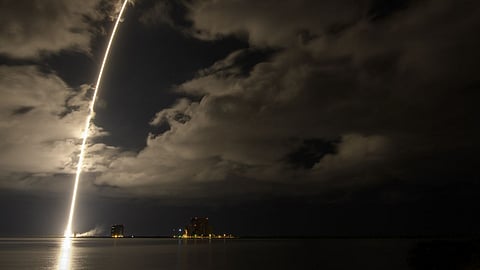

In a novel bid to seek out the origin of our solar system, the US space agency on Saturday launched the Lucy mission, the agency's first to Jupiter's Trojan asteroids.
Launched atop the United Launch Alliance Atlas V 401 rocket from the Cape Canaveral Space Force Station in Florida in the US at around 3 p.m. (India time), Lucy will circle back to Earth three times for gravity assists, making it the first spacecraft to return to the vicinity of Earth from the outer solar system.
During its 12-year primary mission, Lucy will explore a record-breaking number of asteroids, including a flyby of one asteroid in the solar system's main belt and seven Trojan asteroids near Jupiter.
"Lucy embodies NASA's enduring quest to push out into the cosmos for the sake of exploration and science, to better understand the universe and our place within it," said NASA Administrator Bill Nelson. "I can't wait to see what mysteries the mission uncovers!"
Lucy will explore the Trojan asteroids with a suite of remote sensing instruments. Additionally, the navigation cameras will be used to determine the shapes of the Trojan asteroids.
Lucy will be the first spacecraft to study Jupiter's Trojan Asteroids.
These small bodies are remnants of our early solar system, now trapped in stable orbits associated with -- but not close to -- the giant planet Jupiter.
The Trojan asteroids are in two "swarms" that lead and follow Jupiter in its orbit around the Sun and are almost as numerous as the objects in the Main Asteroid Belt.
These primitive bodies hold vital clues to deciphering the history of the solar system.
"A true mission of discovery, Lucy is rich with opportunity to learn more about these mysterious Trojan asteroids and better understand the formation and evolution of the early solar system," said Thomas Zurbuchen, associate administrator for the Science Mission Directorate at the agency's Headquarters in Washington, DC.
The spacecraft's first Earth gravity assist in 2022 will accelerate and direct Lucy's trajectory beyond the orbit of Mars.
The spacecraft will then swing back toward Earth for another gravity assist in 2024, which will propel Lucy toward the Donaldjohanson asteroid - located within the solar system's main asteroid belt - in 2025.
"It will still be several years before we get to the first Trojan asteroid, but these objects are worth the wait and all the effort because of their immense scientific value. They are like diamonds in the sky," said Hal Levison, Lucy principal investigator from the Southwest Research Institute (SwRI).
